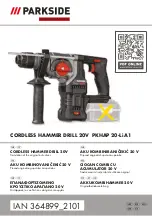
PKHAP 20-Li A1
GB
│
CY
│
5
■
d)
Remove any adjusting key or wrench before
turning the power tool on.
A wrench or a key
left attached to a rotating part of the power tool
may result in personal injury.
e)
Do not overreach. Keep proper footing and
balance at all times.
This enables better control
of the power tool in unexpected situations.
f)
Dress properly. Do not wear loose clothing or
jewellery. Keep your hair, clothing and gloves
away from moving parts.
Loose clothes, jewel-
lery or long hair can be caught in moving parts.
g)
If devices are provided for the connection of
dust extraction and collection facilities, ensure
these are connected and properly used.
Use
of dust collection can reduce dust-related
hazards.
4. Power tool use and care
a)
Do not force the power tool. Use the correct
power tool for your application.
The correct
power tool will do the job better and safer at
the rate for which it was designed.
b)
Do not use the power tool if the switch does
not turn it on and off.
Any power tool that
cannot be controlled with the switch is
dangerous and must be repaired.
c)
Disconnect the plug from the power source
and/or the battery pack from the power tool
before making any adjustments, changing
accessories, or storing power tools.
Such
preventive safety measures reduce the risk of
starting the power tool accidentally.
d)
Store idle power tools out of the reach of
children and do not allow persons unfamiliar
with the power tool or these instructions to
operate the power tool.
Power tools are
dangerous in the hands of untrained users.
e)
Maintain power tools. Check for misalignment
or binding of moving parts, breakage of parts
and any other condition that may affect the
power tool’s operation. If damaged, have the
power tool repaired before use.
Many acci-
dents are caused by poorly maintained power
tools.
f)
Keep cutting tools sharp and clean.
Properly
maintained cutting tools with sharp cutting edges
are less likely to bind and are easier to control.
g)
Use the power tool, accessories and tool bits,
etc., in accordance with these instructions,
taking into account the working conditions
and the work to be performed.
Use of the
power tool for operations different from those
intended could result in a hazardous situation.
5. Use and handling of the cordless
electrical power tool
a)
Charge a rechargeable battery using only
the charger recommended by the manufac-
turer.
There is a risk of fire if a battery charger
designed for a particular type of battery is used
with other batteries.
b)
Only the rechargeable battery units supplied
are to be used with an electrical power tool.
The use of other rechargeable battery units may
lead to the danger of injury or fire.
c)
When they are not being used, store recharge-
able battery units away from paperclips, coins,
keys, nails, screws or other small metal objects
that could cause the contacts to be bridged.
Short-circuiting the contacts of a rechargeable
battery unit may result in heat damage or fire.
d)
Fluids may leak out of rechargeable battery
units if they are misused. If this happens,
avoid contact with the fluid. If contact occurs,
flush the affected area with water. Seek addi-
tional medical help if any of the fluid gets into
your eyes.
Escaping battery fluid may cause
skin irritation or burns.
e)
Do not use a damaged or modified battery.
Damaged or modified batteries may behave
unexpectedly and cause fires, explosions or
pose a risk of injury.
f)
Do not expose a battery to fire or excessively
high temperatures.
Fire or temperatures in excess
of 130°C (265°F) can cause an explosion.
Содержание 364899 2101
Страница 3: ...A KOMPERNASS H GMBH BURGSTRASSE 21 44867 BOCHUM GERMANY ...
Страница 18: ...PKHAP 20 Li A1 14 GB CY ...
Страница 32: ...PKHAP 20 Li A1 28 HR ...
Страница 46: ...PKHAP 20 Li A1 42 RS ...
Страница 60: ...PKHAP 20 Li A1 56 RO ...
Страница 88: ...PKHAP 20 Li A1 84 DE AT CH ...










































